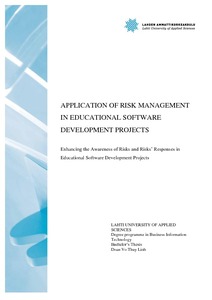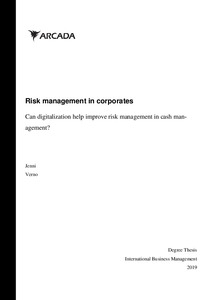Designing a Circular Risk Scorecard (CRIS) to bridge circular economy transitions and financial risk profiles : a theoretical study of 6 Finnish enterprises
Khan, Sameer (2024)
Julkaisun pysyvä osoite on
https://urn.fi/URN:NBN:fi:amk-2024110827686
https://urn.fi/URN:NBN:fi:amk-2024110827686
Tiivistelmä
Current research highlights a significant gap in understanding how circular economy (CE) initiatives impact the financial performance of companies, particularly in resource-intensive sectors where materiality plays a critical role. Materiality, or the relevance of resource efficiency to business operations, strongly influences both circularity and financial performance. This thesis addresses the gap by developing the Circular Risk Integration Scorecard (CRIS), a theoretically grounded framework that provides a structured approach to assessing financial risks tied to circular transitions. CRIS offers companies a flexible template to begin integrating circularity into financial decision-making, with sector-specific adjustments reflecting the unique dynamics of different industries.
CRIS is not a one-size-fits-all model but a starting point that companies can customize based on their individual risk profiles, industry characteristics, and specific needs. It highlights key risk categories, indicators, and actionable insights, allowing businesses to prioritize elements most relevant to their operations. This flexibility is essential for industries with high material dependence, where circular transitions directly affect cost structures, regulatory compliance, and market performance.
To demonstrate CRIS's practical applicability, the framework was theoretically applied to six leading Finnish companies across various sectors. This application showcased CRIS's flexibility in addressing sector-specific dynamics and materiality factors. Additionally, validation interviews with executives from YIT and Fortum provided valuable industry perspectives, affirming the framework's relevance and potential impact.
However, practical application of the CRIS framework will require further development. Data quality, accessibility, and validation remain critical for its successful implementation. These factors will determine how effectively companies can apply CRIS to measure the financial risks and benefits of circular economy efforts. As such, the framework’s adaptability allows companies to capture the unique risks and opportunities presented by their specific circular transitions.
Key findings emphasize that sector-specific adjustments are crucial in assessing the financial risks associated with circularity. This flexibility ensures that businesses across industries can refine and tailor the CRIS framework to their particular contexts. While CRIS provides actionable insights and improves communication with stakeholders, its effectiveness in real-world applications must be validated through further research and refinement. Ultimately, CRIS offers a strategic pathway for companies to navigate the financial complexities of circular transitions, but its future evolution will depend on empirical testing and ongoing development.
Future research should focus on refining CRIS for broader industry use and enhancing its integration into global financial and sustainability reporting standards. The continued evolution of CRIS will provide businesses with a reliable, adaptable tool to measure and manage the financial implications of their circular economy initiatives, enabling a sustainable shift in industries reliant on resource efficiency.
CRIS is not a one-size-fits-all model but a starting point that companies can customize based on their individual risk profiles, industry characteristics, and specific needs. It highlights key risk categories, indicators, and actionable insights, allowing businesses to prioritize elements most relevant to their operations. This flexibility is essential for industries with high material dependence, where circular transitions directly affect cost structures, regulatory compliance, and market performance.
To demonstrate CRIS's practical applicability, the framework was theoretically applied to six leading Finnish companies across various sectors. This application showcased CRIS's flexibility in addressing sector-specific dynamics and materiality factors. Additionally, validation interviews with executives from YIT and Fortum provided valuable industry perspectives, affirming the framework's relevance and potential impact.
However, practical application of the CRIS framework will require further development. Data quality, accessibility, and validation remain critical for its successful implementation. These factors will determine how effectively companies can apply CRIS to measure the financial risks and benefits of circular economy efforts. As such, the framework’s adaptability allows companies to capture the unique risks and opportunities presented by their specific circular transitions.
Key findings emphasize that sector-specific adjustments are crucial in assessing the financial risks associated with circularity. This flexibility ensures that businesses across industries can refine and tailor the CRIS framework to their particular contexts. While CRIS provides actionable insights and improves communication with stakeholders, its effectiveness in real-world applications must be validated through further research and refinement. Ultimately, CRIS offers a strategic pathway for companies to navigate the financial complexities of circular transitions, but its future evolution will depend on empirical testing and ongoing development.
Future research should focus on refining CRIS for broader industry use and enhancing its integration into global financial and sustainability reporting standards. The continued evolution of CRIS will provide businesses with a reliable, adaptable tool to measure and manage the financial implications of their circular economy initiatives, enabling a sustainable shift in industries reliant on resource efficiency.
Kokoelmat
Samankaltainen aineisto
Näytetään aineisto, joilla on samankaltaisia nimekkeitä, tekijöitä tai asiasanoja.
-
Risks and Risk Management in Heavy Lift Transport from Finland to Norway : a qualitative study about the risks and challenges involved in the transportation of heavy lift
Merisaari, Emilia (2020)In this thesis the risks and risk management in Heavy lift transport from Finland to Norway were examined. The objective of this thesis was to identify the risks that can arise during transport of Heavy lift and what ... -
Application of risk management in educational software development projects : enhancing the Awareness of Risks and Risks’ Responses in Educational Software Development Projects
Doan, Linh (Lahden ammattikorkeakoulu, 2015)In real life, it is said that many industrial projects failed because of lacking Risk Management. Therefore, author realized how important to bring the knowledge of Risk Management to educational teams. With understanding ... -
Risk management in corporates; can digitalization help improve risk management in cash management?
Verno, Jenni (2019)The purpose of this study was to investigate if digital solutions help reducing risks related to cash management. The main theories included cash management, risk management and digitalization in finance. The study was ...



